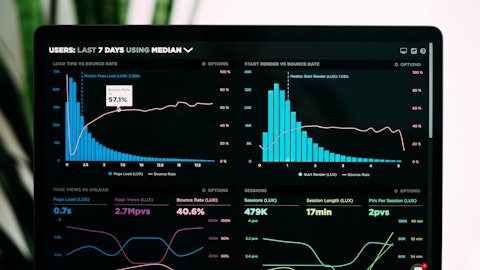Blake Friedman: This is Blake on for Vivek. Thank you for taking my question. Just wanted to drill down more into the fiscal ’24 guidance because I believe in the past, you guys have given a rough breakout between device and material sales in your long-term target and with the new FY ’24 target, Curious if you can break that out again between devices and materials.
Neill Reynolds: Yes. So, I think what we said is — power devices are supplied today out of the Durham fab, and that’s going to run about a quarter. That’s what it’s been capped at that. We saw the RF numbers kind of come down. They’ve been more or less in line with those expectations, and we’ll see the materials business be somewhat muted as we focus on the 200-millimeter wafer. So, you can kind of look at this kind of starting point here. We guided last quarter at $220 million, you add a couple of millions from Mohawk Valley, $222 million in Q4, and all growth after that will come from Mohawk Valley. So, we can kind of get an idea of what the trajectory is and really, it’s power device growth from here out through the end of ’24 is what’s represented in those numbers.
Blake Friedman: Great. Helpful. And then just as a follow-up from a CapEx perspective, I know — I believe you said it kind of came in under expectations for this year, but just moving forward, kind of at lower revenue levels at this point, I just want to confirm that the plans you laid out at your Analyst Day are still roughly in line with what you’re thinking?
Neill Reynolds: Yes. I don’t think there’s any change to the total build-out or cost of build out or anything like that versus what we talked about. I think we’re seeing a little bit slower spend on some of the facilities and structures that we’re seeing from a CapEx perspective, particularly on the Siler City project. But I think of that more as timing. We’ll see about, like I said in the prepared remarks, about $2 billion of CapEx in ’24. It could be variable depending on a number of things. But the vast majority of that is focused on bringing on 200-millimeter materials substrate capacity to support Mohawk Valley. So that’s really where our focus is both from an execution perspective and from an investment perspective, to bring that type of capacity online, again, with the intention of ramping Mohawk Valley as fast as possible.
Blake Friedman: Thank you.
Operator: And the final question on the line comes from Pierre Ferragu from New Street.
Pierre Ferragu: Thanks, for taking my question. So, it’s going to be the last question. And I’m sorry, I’m going to ask again about like the delay and things like that. But what I wanted to do is really to make sure I understand it at a high level. What I’m understanding is that roughly at the end of this fiscal year, so in a year from now, in June 2024, you’ll be about 20% behind schedule compared to what your previous guidance was meaning. And it’s just because it’s taking you may be about 20% longer to get started in ramping materials production. And I think in the numerous questions we heard about that, you qualified that as being like maybe running three or six months behind plan. So, I just wanted to make sure at a high level, that’s the way we should understand it.
Everything is going fine. The yields are fine. Things are just like walking through all what you have to do to run this production capacity is just running three to six months behind schedule. Is that the right way to think about it?
Neill Reynolds: Yes. Thanks for the question. Yes, I think that’s the right way. The goal is to get the utilization of the fab to 20% by the end of 2024, and that’s what’s baked into the model. And I kind of consider that kind of a risk-adjusted plan because it’s got a lot of different moving pieces right now, and we’ll have to work through any bumpiness. But I think that accounts for that as we look at that. And as it relates to the three to six months behind, or whatever you want to call it, I think that’s true. I think initially, we had planned kind of in the back half of fiscal year 2023, we would ramp the fab, and we’re all we kind out in the June quarter with roughly $2 million of revenue. So, it’s probably a little bit — probably further than that.
Another piece of it is a slope of the ramp, right? We’re going to be more methodical in terms of how we bring it up. So, I think it’s really about — so if you think about the overall financial impact, that’s why it becomes more dramatic than that and maybe pushes out a bit further. But again, it’s really this time frame because once you get to that 20% utilization point, and we bring up that level of capacity, we believe as you get out beyond ’24, to ’25 and ’26, it can accelerate again because we’ll just have more capability under our belt. It won’t be in those early days of building this type of capacity after the first time.




